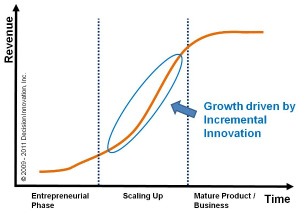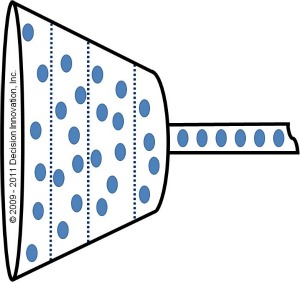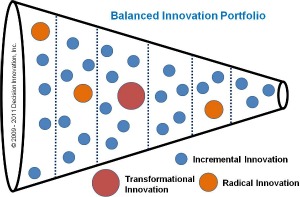Using incremental innovation to grow your business with low risk
 In today's rapidly changing business landscape, incremental innovation can often be underrated when compared to other innovation types. Business leaders often assert high overall innovation failure rates, varying anywhere between 70 to 98%. Contending with this level of failure makes incremental changes look attractive when considering the risk associated with innovation investments.
In today's rapidly changing business landscape, incremental innovation can often be underrated when compared to other innovation types. Business leaders often assert high overall innovation failure rates, varying anywhere between 70 to 98%. Contending with this level of failure makes incremental changes look attractive when considering the risk associated with innovation investments.
Characteristics that distinguish incremental improvement
Change impact or scope is the key aspect used to differentiate incremental from radical, breakthrough, or transformational types of innovation. Incremental innovation is characterized by:
- Utilizing or enhancing current core competencies and capabilities
- Modest technological changes from existing platforms, products, or services
- Responding to customer needs identified from current offers
- A more predictable path or process, particularly with respect to costs
- Often following a formal stage-gate process
- Prolonging the market life of a product or service while sustaining the competitiveness of existing products in the market
- Enabling continued growth with low risk
In some cases these incremental improvements may provide advantage to existing industry players as they capitalize on existing knowledge, resources, and processes. This type of innovation can also reconfigure current capabilities to serve a new use or need.
Choosing the best innovation investments
 Incremental innovation most often moves along the established innovation framework for the business. In many cases, the business will have an established pipeline that evaluates new concepts and ideas that can move through the service or product innovation process within a defined level of risk. Factors that can establish viability as an incremental improvement include:
Incremental innovation most often moves along the established innovation framework for the business. In many cases, the business will have an established pipeline that evaluates new concepts and ideas that can move through the service or product innovation process within a defined level of risk. Factors that can establish viability as an incremental improvement include:
- Time to market - The innovation can hit an expected market window for the enhancement. Often, this includes being able to maintain a steady flow to the market that will match forecasted demand.
- Low technology, architectural, platform or process risk - Technology, architecture, platform and process changes can take longer than estimated and open new possibilities for failure. Innovation activities for enhancements will generally avoid these risks by limiting or avoiding changes in these areas.
- Low resource risk - Incremental changes will have manageable impacts on resources. Frequently, innovation project management will seek to reduce risks for supply chain resources and partners.
- Comprehensible or obvious change for the customer base - Incremental advances will be easily understood and adopted by established and newly targeted customers.
- Cost or price reduction - Changes that reduce cost or price are common enhancements that can enhance growth by broadening market reach.
- Performance or effectiveness - Improvements will match or slightly exceed competitive offers in established performance areas.
- Regulatory compliance - Innovation may be needed to meet ongoing changes to regulatory or standards requirements.
- Experience - Small improvements in experience can provide significant customer value and provide opportunity for innovation across the organization.
An attractive source of incremental innovation can also be found through established suppliers and partners where their technology improvements can be used as potential components in a new offer to customers.
How much of investment should go to incremental innovation?
There is an abundance of information available that can influence decision making on where best to innovate. We often experience conflicting motivations to consistently improve existing products and services while also trying to be vigilant for "game changing" innovation opportunities. Ultimately, innovation investments must find the critical balance of short term, medium term, and long term ventures that provide needed growth while preparing for long term survival.
Finding this balance is a key goal in managing innovation and should be guided by the strategy for the business. Investments in incremental innovation should take the largest portion of the innovation budget as they fuel the low risk near term growth, typically in the zero to two year time horizon. However, discipline in the portfolio decision analysis must ensure that the incremental enhancements are generating the projected returns on innovation, particularly when base innovation diffusion (per Everett Rogers) has moved past the early majority adoption phase. Investments in incremental changes that exceed 90% of the allocation for innovation may be pointing to a problem, particularly if it is happening consistently.
When is incremental innovation inadequate?
 At some point in a category lifecycle there will be signs that incremental changes are not enough to sustain viability for your business. Here are some of the warning signs:
At some point in a category lifecycle there will be signs that incremental changes are not enough to sustain viability for your business. Here are some of the warning signs:
- Cost/Price reductions no longer generate the increase in sales needed to make an adequate return on the cost reduction investment.
- The investment needed to maintain the product/service innovation pipeline is degrading profitability.
- The success rate of innovation activities is falling well below expectations.
- Investment in innovation projects are exceeding developers' estimates.
- "Ticket to play" projects that do not provide a return consume an increasing portion of the innovation budget.
- Market penetration for the product or service has passed beyond the early majority (about 50% of the population).
Balancing the innovation portfolio
 We can become absorbed with radical or disruptive innovation but, most growth is achieved through a steady stream of incremental innovation that is more frequent and economically predictable. The success rate of radical innovations is amazingly small, likely less than 10%.
We can become absorbed with radical or disruptive innovation but, most growth is achieved through a steady stream of incremental innovation that is more frequent and economically predictable. The success rate of radical innovations is amazingly small, likely less than 10%.
Small improvements can add up to significant change over time, and represents continuous learning by researchers, managers, developers, suppliers and customers. Incremental change is the key source for low risk growth and successful innovation management must establish the balance between evolutionary and revolutionary initiatives that will grow and sustain the business for the short and long term.

